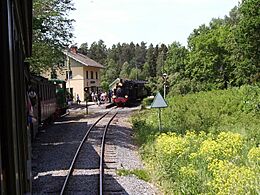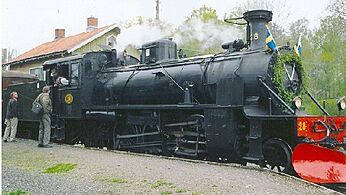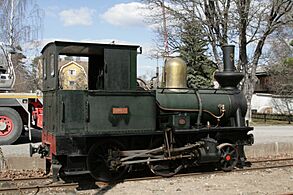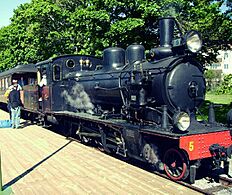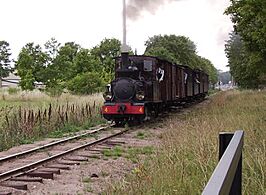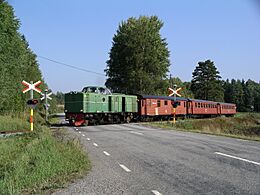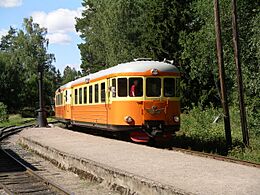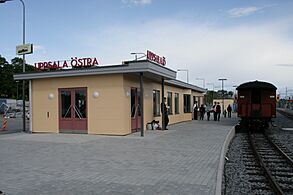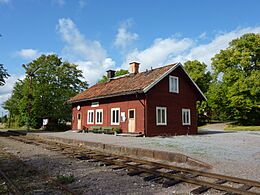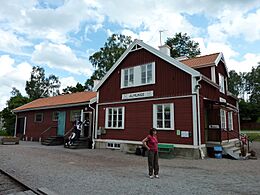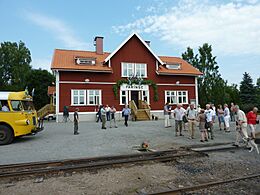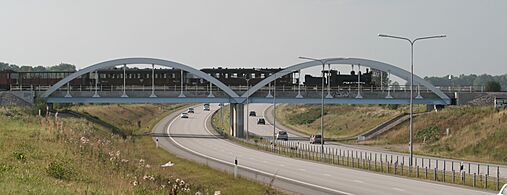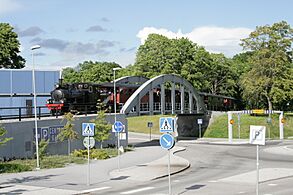Upsala–Lenna Jernväg facts for kids
The Upsala–Lenna Järnväg (ULJ) is a special old railway in Uppsala County, Sweden. It is also known as "Lennakatten". This railway is a narrow-gauge line, which means its tracks are closer together than regular train tracks. It is a heritage railway, meaning it is preserved and run for its historical importance, often for fun trips. The ULJ is about 33 kilometers (20 miles) long. It was once part of a much larger network of narrow-gauge railways in an area called Roslagen. The tracks are 891 millimeters wide, a size unique to Sweden. A group called SRJmf helps run this historic railway.
Contents
The Story of the Railway
How the Railway Started
The railway line between Uppsala and Lenna (now spelled Länna) first opened in 1876. It was the very first 891 mm wide railway in that region. It was built to help the ironworks in Länna. It connected them to the main railway network, which had wider tracks (1435 mm). The railway builders chose the 891 mm track width as a good compromise. A smaller track might have been enough for iron ore, but a slightly wider one allowed them to carry passengers, mail, and other goods too.
Two years later, in 1878, another 891 mm railway called the Dannemora–Harg railroad (DHJ) started operating in the northern part of the county. This line was built to connect the mines in Dannemora to the harbor at Hargshamn.
Growing the Network
In 1884, the ULJ line was connected to the coast by the Lenna–Norrtelje Railroad (LNJ). The next year, that line connected through Rimbo to Stockholm by the Stockholm–Rimbo Railroad (SRJ).
The SRJ company bought the LNJ in 1905 and the ULJ in 1908. In 1909, the company changed its name to Stockholm–Roslagens Järnvägar (Stockholm–Roslagen Railroad). This allowed them to keep their well-known initials, SRJ. Roslagen is the historical name for the coastal area north of Stockholm. SRJ also helped build a new line north from Rimbo, which reached Hallstavik in 1915. By 1920, the DHJ (which was then owned by SRJ) was connected to the rest of the railway system by the Faringe–Gimo line.
Changes and Closures
Some parts of the railway network, starting from Stockholm, were electrified (meaning trains ran on electricity) as early as 1895. This project finished in 1949 when the Rimbo–Norrtälje line also got electricity.
After World War II, many railways started to be used less. The SRJ/DHJ network was taken over by the government in 1951. Eight years later, in 1959, it became part of the Swedish State Railways (SJ).
During the early 1950s, three lines that only carried freight (goods) were closed. In 1960, passenger trains stopped running on the Dannemora–Harg and Faringe–Gimo lines. Passenger service also stopped on the line from Stockholm Östra station to Engelbrektsplan in central Stockholm. This was a city line, and steam trains rarely used it.
Six years later, in 1966, a commuter line from Stocksund to Långängstorp was closed. This line was originally built with standard-gauge tracks but was changed to narrow-gauge in 1934. In 1966, passenger trains stopped running on the Uppsala–Rimbo–Hallstavik line. Then, in 1969, just twenty years after it was electrified, the Rimbo–Norrtälje line was closed. In the same year, freight trains stopped running south of Rimbo.
New Tracks and New Owners
However, freight traffic was still busy on some parts of the network. The Dannemora mines still sent iron ore through the harbor at Hargshamn. Also, freight trains used special wagons to carry goods to and from the paper mill at Hallstavik, traveling via Uppsala–Rimbo. Because of this, the national railway decided to change the old DHJ line to standard gauge. This change was finished in 1970. At the same time, all trains stopped running on the Faringe–Gimo line.
A new standard-gauge line was built from Hargshamn to Hallstavik in 1977. After this, the special freight trains from Hallstavik to Rimbo and Uppsala stopped running.
In 1972, the Storstockholms Lokaltrafik (SL) company took over the remaining lines that still carried passengers. These were the lines south of Rimbo. Rimbo was now cut off from the northern network, including the Upsala–Lenna Järnväg. SL closed the Djursholms Ösby–Eddavägen line in 1976. In 1981, the old railway hub at Rimbo lost all its railways when the Kårsta–Rimbo line was closed. This made the small village of Kårsta the new northern end of the line. The part of the railway that is still used today is called Roslagsbanan. It is a very important part of Stockholm's commuter train system.
The SRJmf Society
The SRJmf society was started in 1968. Its main goal was to save old trains and railway cars from the SRJ/DHJ network. They wanted to use them for special trips. At first, the society was based in Stockholm and ran trips on different parts of the network. As the SJ started closing parts of the railway, people talked about turning some sections into heritage railways. The Finsta–Syninge section (closed in 1967) and Faringe–Gimo were strong possibilities.
In the early 1970s, the SJ started building the new standard-gauge line from Hargshamn to Hallstavik. The SRJmf society realized that the Uppsala–Rimbo–Hallstavik line would no longer be used for freight. This gave the society a chance to start running trains on the beautiful line near Uppsala.
With help from the Municipality of Uppsala, the society started running trains on Sundays in the summer of 1974. This was when freight trains were not running. Three years later, the Hargshamn–Hallstavik line opened, and all train traffic stopped on the Uppsala–Rimbo–Hallstavik line. The society was then able to take over the Uppsala–Länna–Faringe line. The City of Uppsala owned the tracks. Faringe, which used to be a railway junction, became the society's main base with workshops. The tracks between Faringe and Rimbo were removed in 1978.
-
SRJ 28 Stortysken at Lenna Station (in Länna) in June 2005. This is one of the biggest steam locomotives ever built for 891 mm tracks.
What Happens Today
Regular Train Trips
Today, trains usually run on Sundays from June to early September. In July, they run four days a week. Many school trips and other special group trips happen in late May and throughout the year.
On a typical Sunday, you might see two trains pulled by steam engines and one train pulled by a motorcar. There are also old buses that take people to the Fjällnora open-air baths.
Weekday Services
Weekdays are often similar to Sundays. Sometimes, one of the steam trains might be replaced by a diesel train. There is usually an early extra train connection to Faringe and the Thun's outlet store.
See also
 In Spanish: Upsala-Lenna Jernväg para niños
In Spanish: Upsala-Lenna Jernväg para niños
- List of heritage railways
- Roslagsbanan


